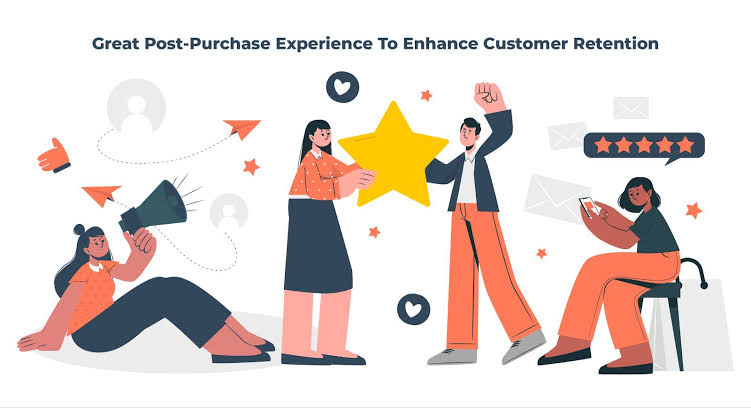Creating a Seamless Shopping Experience: 5 Practices to Eliminate Post-Purchase Dissonance

In the realm of e-commerce, where the boundaries between physical and virtual shopping continue to blur, the pursuit of customer satisfaction is an ongoing endeavor. A successful transaction is no longer the final chapter of a consumer’s journey; it’s the prologue to the post-purchase experience, a critical phase that can define a brand’s reputation and foster long-term loyalty.
Post-purchase dissonance, the nagging doubt that arises after a purchase, can be detrimental to both customers and businesses. To ensure a seamless shopping experience, Here are five essential practices to reduce post-purchase dissonance.
Contents
- 1 1. Transparent Product Information: Bridging the Expectation Gap through Comprehensive Details and Visual Clarity
- 2 2. Responsive Customer Support: A Safety Net of Assurance, Guiding Customers Through Every Query and Concern
- 3 3. Post-Purchase Engagement: Nurturing the Relationship Beyond the Transaction, Cultivating Bonds of Trust and Loyalty
- 4 4. Hassle-Free Returns and Exchanges: Embracing Flexibility to Ensure Customer Confidence and Satisfaction
- 5 5. Personalization and Recommendation: Tailoring the Experience to Elevate Customer Satisfaction and Engagement
- 6 Conclusion
1. Transparent Product Information: Bridging the Expectation Gap through Comprehensive Details and Visual Clarity
The foundation of a seamless shopping experience rests upon the bedrock of transparent product information. In the intricate dance between consumers and brands, where digital interactions replace physical inspections, the role of product information becomes paramount. It is the guiding star that navigates customers through the virtual aisles, enabling them to make informed decisions. Transparent product information is not merely a static description; it’s an immersive experience that transcends the digital screen.
Clarity is the currency of trust in this practice. High-resolution images, captured from various angles, unveil the product’s nuances, leaving no room for ambiguity. Each pixel becomes a brushstroke painting the canvas of expectations. Accompanying these images are detailed specifications that offer insights into dimensions, materials, features, and functionalities. It’s not just a product; it’s a story told through facts and visuals.
Authenticity becomes the cornerstone of this practice. Exaggerations and embellishments are left at the digital doorstep. Instead, what customers see is what they get. This practice bridges the chasm between imagination and reality, aligning customer expectations with the actual product. It’s an unspoken promise that whispers, “What you see is what you’ll receive.”
2. Responsive Customer Support: A Safety Net of Assurance, Guiding Customers Through Every Query and Concern
In the labyrinth of e-commerce, where clicks and keystrokes replace face-to-face interactions, responsive customer support emerges as a beacon of assurance. It’s the safety net that catches customers when they teeter on the edge of uncertainty.
A seamless shopping experience extends beyond the digital realm; it’s an emotional journey, and responsive customer support is the empathetic guide that holds the customer’s hand through every step.
Responsive email support ensures that customer questions find their way to attentive inboxes, receiving timely and meaningful responses. It’s not just support; it’s a lifeline, swiftly thrown when customers wade into the waters of doubt.
3. Post-Purchase Engagement: Nurturing the Relationship Beyond the Transaction, Cultivating Bonds of Trust and Loyalty
In the symphony of commerce, the final note of a purchase does not mark the end; it’s a prelude to an encore. Post-purchase engagement emerges as a harmonious refrain, a continuation of the brand-consumer duet. It’s the art of nurturing the relationship beyond the transaction, transforming a single act of purchase into a series of meaningful interactions.
But post-purchase engagement is not confined to mere courtesies; it’s a stage for continued storytelling. Brands extend an invitation to customers, urging them to share their experiences, provide feedback, and even contribute reviews. This invitation isn’t a formality; it’s a cornerstone of co-creation. It transforms customers from passive recipients into active participants, forging a sense of ownership in the brand’s narrative.
4. Hassle-Free Returns and Exchanges: Embracing Flexibility to Ensure Customer Confidence and Satisfaction
In the delicate dance of e-commerce, where pixels replace touch and virtual baskets replace shopping carts, the practice of hassle-free returns and exchanges emerges as an embodiment of flexibility. It’s an acknowledgment that customer preferences and choices are respected, even after the transaction is complete. Hassle-free returns and exchanges aren’t just a policy; they’re a statement of a brand’s commitment to customer confidence and satisfaction.
Clear instructions guide customers through the return process, dispelling uncertainties. Providing prepaid return labels is a gesture that transforms a potential headache into a seamless process. It’s a signal that the brand stands ready to facilitate, not hinder, the customer’s choice.
Embracing flexibility goes beyond procedure; it’s about the customer’s peace of mind. It’s understanding that sometimes a product doesn’t meet expectations, and that’s okay. Hassle-free returns and exchanges shift the focus from the product to the customer experience. They create an environment where customers feel safe to explore without the fear of being trapped.
5. Personalization and Recommendation: Tailoring the Experience to Elevate Customer Satisfaction and Engagement
In the ever-evolving landscape of e-commerce, where algorithms decipher preferences and data shapes experiences, the art of personalization and recommendation emerges as a symphony of tailored engagement. It’s the digital tailor that stitches a bespoke shopping journey, ensuring that each customer step is guided by individual preferences and needs. Personalization and recommendation aren’t just strategies; they’re the embodiment of a brand’s dedication to elevating customer satisfaction and engagement.
In this practice, data is the brush that paints the portrait of customer desires. Analyzing browsing history, purchase patterns, and demographic information enables brands to curate personalized suggestions. These suggestions are not random; they’re a whisper of understanding that echoes, “We know what you like. We’re here to make it easier for you.”
But personalization doesn’t just stop at product recommendations; it extends to the entire journey. Personalized landing pages greet customers by name, offering curated selections that resonate with their tastes. Email communication addresses customers by their preferred titles, adding a touch of familiarity to the digital correspondence. It’s not just about selling; it’s about connecting.
Conclusion
In an era where competition is fierce and consumer expectations are high, creating a seamless shopping experience is not a luxury; it’s a necessity. The journey from browsing to post-purchase engagement is a narrative that should be woven with threads of trust, transparency, and empathy. By implementing practices that encompass transparent product information, responsive customer support, post-purchase engagement, hassle-free returns, and personalized recommendations, brands can craft a tapestry that eliminates post-purchase dissonance.
The ultimate goal is to create an environment where customers feel valued, heard, and understood. A seamless shopping experience extends beyond the confines of a digital transaction, transcending into the realm of emotions and perceptions. It is a commitment to building relationships that withstand doubts, uncertainties, and challenges. As brands embrace these practices, they embark on a journey towards lasting customer loyalty, transforming every transaction into a chapter of trust and every post-purchase moment into an opportunity to shine. In a world where choices abound, the seamless shopping experience becomes a beacon, guiding customers towards a haven of satisfaction, and brands towards a legacy of excellence.

![Anilox Roll Cleaner: Keeping Your Printing Business Running Smoothly 2 If you're in the printing business, you're likely familiar with the essential role of anilox rolls in achieving high-quality prints. These precision-engineered, engraved cylinders transfer ink to printing plates, ensuring vivid and consistent images. To maintain the performance of these critical components, regular cleaning with an anilox roll cleaner is imperative. Introduction What is anilox roll cleaner? Anilox roll cleaner is a specialized cleaning solution designed to remove ink and other contaminants from anilox rolls. Regular cleaning not only extends the life of your anilox rolls but also enhances print quality. Benefits Efficient ink removal Anilox roll cleaner excel at efficiently removing ink buildup from the cells of the rolls. This prevents clogs and ensures a consistent ink transfer, resulting in sharp and vibrant prints. Prolonged anilox roll life Regular cleaning prevents long-term ink residue buildup, which can damage the delicate engravings on the rolls. This extends the lifespan of your anilox rolls, saving you money in the long run. Improved print quality Clean anilox rolls deliver superior print quality with sharper images and more accurate color reproduction. This not only pleases your clients but also elevates your brand's reputation. Types Liquid anilox roll cleaners Liquid cleaners are easy to apply and penetrate deep into the roll cells, providing a thorough cleaning. They are suitable for regular maintenance. Gel anilox roll cleaners Gel cleaners are slightly more viscous, making them ideal for removing stubborn ink buildup. They are a great choice for deep cleaning. Foam anilox roll cleaners Foam cleaners offer convenience and are often used for quick, routine cleaning. They are gentle on the rolls while effectively removing light ink residue. How to Use Step-by-step guide 1. First, identify the type of anilox roll cleaner you have. 2. Follow the manufacturer's instructions for application. 3. Use a soft brush or sponge to gently scrub the roll's surface. 4. Rinse thoroughly with water to remove all traces of the cleaner. 5. Dry the roll completely before reassembling it. Best Practices Regular maintenance Cleaning your anilox rolls regularly is essential for maintaining peak performance. Aim to clean them after every job or as recommended by the manufacturer. Safety precautions When handling anilox roll cleaners, wear appropriate protective gear, including gloves and safety glasses. Ensure good ventilation in your workspace. DIY Cleaners Baking soda and water For a simple homemade solution, mix baking soda and water to create a paste. Apply it to the roll, scrub gently, and rinse thoroughly. Vinegar and water Another DIY option is a mixture of vinegar and water. This is effective for routine cleaning but may not tackle heavy ink buildup. Commercial Cleaners Recommendations For commercial-grade anilox roll cleaners, consider trusted brands such as [Brand X] and [Brand Y]. These products are formulated for maximum effectiveness. Environmental Impact Eco-friendly options If you're concerned about the environmental impact of your cleaning process, look for eco-friendly anilox roll cleaners. These products are biodegradable and less harmful to the environment. Conclusion In the fast-paced world of printing, maintaining the quality of your products is paramount. Anilox roll cleaner plays a crucial role in ensuring that your anilox rolls continue to perform at their best, delivering sharp, high-quality prints. Invest in regular maintenance and cleaning to keep your printing business running smoothly. FAQs What is the purpose of anilox roll cleaner? Anilox roll cleaner is used to remove ink and contaminants from anilox rolls, ensuring optimal print quality. How often should I clean my anilox roll? Cleaning your anilox roll after each job or as recommended by the manufacturer is a good practice. Can I make my anilox roll cleaner at home? Yes, you can create a simple anilox roll cleaner using baking soda and water or vinegar and water for routine cleaning. Are there any safety concerns when using these cleaners? Yes, safety is important. Wear protective gear, ensure good ventilation, and follow the manufacturer's safety guidelines. What are the best practices for anilox roll maintenance? Regular cleaning, following manufacturer recommendations, and investing in high-quality commercial cleaners are key practices for anilox roll maintenance.](https://bytevarsity.net/wp-content/uploads/2023/10/maxresdefault.jpg)




